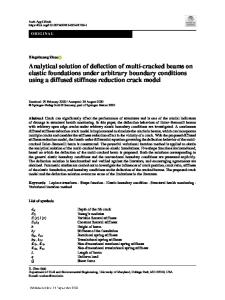Analytical modeling of solution-phase diffusion in porous composite electrodes under time-dependent flux boundary condit
- PDF / 1,452,642 Bytes
- 12 Pages / 595.276 x 790.866 pts Page_size
- 49 Downloads / 358 Views
ORIGINAL PAPER
Analytical modeling of solution-phase diffusion in porous composite electrodes under time-dependent flux boundary conditions using Green’s function method Mohammad Parhizi 1 & Ankur Jain 1 Received: 4 May 2020 / Revised: 12 August 2020 / Accepted: 7 September 2020 # Springer-Verlag GmbH Germany, part of Springer Nature 2020
Abstract Mathematical modeling of species transport in a Li-ion cell is important for understanding and optimizing the performance of Liion cells in a wide variety of energy conversion and storage processes. Specifically, solid- and liquid-phase diffusion in the electrodes is an important process that governs cell performance. Most analytical and numerical models developed in the past have focused on a constant current boundary condition. However, time-dependent boundary conditions may be important in many applications, where the applied charging or discharging current changes with time. This paper presents an analytical solution for the solution-phase diffusion limitation problem for a composite electrode operating under time-dependent flux boundary condition and arbitrary initial conditions using the Green’s function approach. Results based on the analytical solution show good agreement with past work for constant current boundary conditions, as well as numerical simulation results. The results are used to predict the concentration distribution for linear, periodic, and step-function variations in current density as a function of time. Results from the step-function boundary condition address practical applications where sudden changes in the magnitude and direction of the imposed current may occur. Results derived for periodic functions are also of practical significance since other current profiles can be represented by series comprising periodic functions. This work expands the theoretical understanding of diffusion in Li-ion cells, and provides the basis for understanding and optimizing important charge/discharge processes in Li-ion cells. Keywords Li-ion cells . Solution-phase diffusion . Porous electrode . Analytical modeling . Green’s function
Nomenclature a Specific interfacial area (m−1) c Non-dimensional concentration, c = C/C0 C0 Reference concentration (mol m−3) C Concentration (mol m−3) D Diffusion coefficient of electrolyte in the solution (m2s−1) f(x) Non-dimensional initial concentration, f(x) = F(x)/C0 F(x) Initial concentration (mol m−3) F Faraday’s constant (C mol−1) g Non-dimensional generation or consumption G Green’s function
* Ankur Jain [email protected] 1
Mechanical and Aerospace Engineering Department, University of Texas at Arlington, 500 W First St, Rm 211, Arlington, TX 76019, USA
I jn J k Ls Lc r t t+ x X α ε ω τ λ
Current density (A/m2) Pore wall flux, jn = -I/aFLc (mol m−2 s−1) Non-dimensional pore wall flux, J = -I(1-t +)Ls2/ FDLcC0 Non-dimensional constant Length of the separator (m) Length of the porous electrode (m) Ratio of electrode length to separator length, r = Lc/Ls Non-dimensional time, t = Dτ/Ls2 Transference number Non-dimensional
Data Loading...











